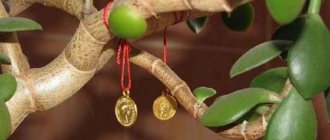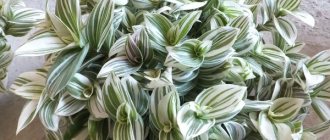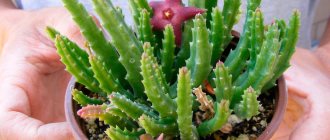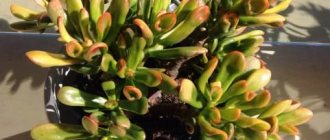Author: Elena N. https://floristics.info/ru/index.php?option=com_contact&view=contact&id=19 Category: Houseplants Published: August 14, 2018Last edits: January 11, 2021
- Diseases and their treatment
- Pachypodium lamerei
Pachypodium (lat. Pachypodium) is a genus of tree-like plants of the Kutrovye family, which grow in the arid regions of Madagascar, Africa and Australia. There are 23 species in the genus. Translated from Greek, “pachypodium” means “thick leg”: the plant has a voluminous, fleshy and prickly trunk. In nature, pachypodium can reach a height of eight meters and a diameter of one and a half meters, but at home this tree does not grow above a meter.
Planting and caring for pachypodium
- Flowering: in spring, first time - in the sixth or seventh year of life.
- Lighting: bright diffused light.
- Temperature: in summer – from 20 to 30 ºC, in winter – 16-18 ºC. Protect the plant from drafts!
- Watering: in spring and summer - moderate, when the substrate dries to a depth of 1 cm, in winter - rare and meager. After dropping the leaves, stop watering. The short-stemmed species requires scanty watering throughout the year.
- Humidity: normal.
- Feeding: from early spring to mid-autumn once a month with fertilizers for cacti.
- Dormant period: approximately November to March.
- Transplantation: young plants - every spring, adults - once every 3-4 years.
- Reproduction: by seeds, less often by cuttings.
- Diseases: fungal rot.
- Pests: spider mites, thrips.
- Properties: the plant has poisonous juice!
Read more about growing pachypodium below.
How to replant a plant correctly
Pachypodium, like other succulents, does not differ in growth rate. However, young plants need to be replanted annually. For adults, one procedure every 2-3 years is enough.
The plant does not need a large pot. Each time its diameter is increased by 2–3 cm. In this case, the container must be deep enough. Be sure to have one or more drainage holes. It is better to choose ceramic pots. The plastic ones are very light, the above-ground part can overweight, and the flower will tip over.
The pachypodium pot should be quite heavy and stable
Pachypodium does not need nutritious soil. In nature, it successfully survives on bare rocks. There is a special soil for sale for cacti and succulents, but experienced gardeners prefer to mix the substrate themselves. It is desirable that it be neutral or slightly acidic (pH 5.0–7.0).
- peat chips, coarse sand, universal soil for indoor plants or garden soil (3:3:1);
- turf and leaf soil, sand (1:1:3).
Botanical description
Pachypodiums are succulent shrubs or trees, the characteristic feature of which, despite the many differences between species and varieties, is a thick trunk that retains a supply of water in case of drought. Otherwise, the appearance of Pachypodium species is varied and ranges from bottle-shaped dwarfs to cactus-like trees. Almost all types of pachypodium are equipped with spines, which are grouped in triplets or pairs and arranged spirally or in rings around the trunk. Branching is also characteristic of plants of this genus, but among pachypodiums there are species that do not form branches. Unlike other representatives of the Kutrovye family, the juice of pachypodiums is not milky, but transparent, although just as poisonous.
In indoor culture, the pachypodium plant grows from 30 to 150 cm, and its lifespan is from 3 to 15 years.
Folk signs and superstitions
The following signs and folk beliefs are associated with the Madagascar palm tree:
- palm trees accepted as a gift will bring grief to the family; to avoid misfortune in the house, you need to buy the flower with a coin;
- the Madagascar palm tree transforms negative energy into positive;
- when the pachypodium begins to bloom, the house is filled with love and goodness;
- the flower will protect its owners from unfriendly guests, they will feel tired;
- in the house in which this flower is located, fidelity will remain, all family members will become closer;
- since pachypodium belongs to the cactus family, it cannot be kept in the bedroom, because the flower can adversely affect human health;
- cacti and flowers of the cactus family contribute to the emergence of alcoholism in the family, and unmarried girls are condemned to the crown of celibacy;
- single women who collect different types of succulents can find a man and get married successfully.
Whether to believe these signs and superstitions is a personal matter for everyone. But despite this, there are many couples who live happily growing pachypodium
Pachypodium is a fairly popular, although unsafe flower in everyday life, which requires sufficient care and precautions. Knowing signs and superstitions and believing in them, you can prevent problems in the family
Was this article helpful?
Thank you for your opinion!
You can recommend this article to your friends!
You can recommend this article to your friends!
Yes
No
Pachypodium care at home
Growing conditions
Pachypodium needs a lot of light, and it is not afraid of sunlight. In the summer, he will feel great on the balcony or in the garden, but he needs to be accustomed to the open air. It is better to keep the flower indoors on a south, south-west or south-east window sill. When spring comes after short winter days, the pachypodium also needs to be gradually accustomed to exposure to direct sunlight.
- Preparing soil for seedlings
Pachypodium loves fresh air, but does not tolerate drafts. Temperature in the summer does not play a special role for the plant: pachypodium grows and develops well at both 20 and 30˚C. In winter, the plant requires cool maintenance: the pachypodium spends its dormant period at 16-18 ˚C.
Watering
Caring for home pachypodium is simple. In spring and summer, watering should be moderate so that the soil in the pot is slightly moist all the time. If the plant lacks water, it will shed its leaves and lose its attractiveness, and if there is a lot of moisture, the pachypodium at home will begin to stretch painfully, which will also not add decorative value to it. Water the plant when the soil in the pot dries to a depth of 1 cm. Short-stemmed pachypodium requires scanty watering throughout the year. If the plant has dropped its leaves, stop watering altogether, and after 5-6 weeks the leaves will grow back.
About growing milkweed - a lot of species and varieties
The plant does not need high air humidity, but it will favorably accept your care if you wipe its leaves with a damp sponge from time to time and spray it with settled water at room temperature from a spray bottle. By the way, water for irrigation also needs to be settled.
Fertilizer
The pachypodium plant is fertilized from early spring, when new shoots begin to grow, until mid-autumn. Fertilizer in the form of a fertilizer solution for cacti is applied to pre-moistened soil once a month.
You cannot fertilize pachypodium for a month after transplantation and when it is sick.
Before entering the dormant period, feeding is stopped and resumed only next spring.
- Flowers for the lazy
Transfer
Young pachypodiums need to be transplanted into a larger pot every spring, and adults once every three or even four years. Moderately acidic soil for cacti is optimal for the plant. If you can’t find it in the store, you can make a substrate from equal parts of coarse-grained river sand, turf and leaf soil. To improve drainage qualities, brick chips or charcoal should be added to the substrate. However, this does not eliminate the need to place a layer of expanded clay in the pot when replanting, filling the container to a third of its volume.
When replanting indoor pachypodium, try to act carefully so as not to damage the root system of the plant. If the succulent is healthy, simply transfer it from the old pot to the new one and fill the remaining space with potting soil. Free a plant with diseased roots from the old soil, remove rotten or dried areas, treat the wounds with charcoal powder and only then complete the replanting.
Pachypodium flowering
The indoor pachypodium flower grows very slowly, so you have to wait six or seven years for its first flowering, but if the plant is poorly or improperly cared for, it may not bloom at all. Follow the rules for caring for your succulent, avoid drafts in the room, make sure the plant gets enough food and light, and then one day you will be lucky enough to see pachypodium flowers.
Virulence
Pachypodium secretes poisonous juice, which irritates mucous membranes and corrodes wounds on the skin, so it should be washed off immediately with plenty of water.
In the photo: How pachypodium blooms in an apartment
Optimal microclimate for growing pachypodium
In nature, pachypodium is accustomed to truly extreme conditions, which are almost impossible to recreate at home. Nevertheless, the plant has quite successfully adapted to an unusual microclimate.
The place for the pachypodium is chosen once and for all. He reacts very negatively to any movement. Even a slight rotation of the pot can cause all or most of the leaves to be lost.
Table: how to create optimal conditions for pachypodium
| Factor | Recommendations |
| Location | Window sill facing south, southeast, southwest. In summer, it is useful to expose the pot to fresh air, protecting the plant from rain and cold drafts. It must be carefully protected from the latter even in the apartment. The pachypodium is gradually accustomed to new conditions. |
| Lighting | Loves bright light and direct sunlight. It will not die in partial shade, but will stretch out unsightly. In autumn and winter, additional lighting will be needed with fluorescent or special phytolamps. In spring, the flower will need to be gradually accustomed to natural light again. |
| Air humidity | Not important at all. The plant is quite happy with the air in the apartment (usual humidity is about 50%). Pachypodium leaves are sprayed and wiped mainly for sanitary purposes. |
| Temperature | The plant tolerates any heat without problems, feeling quite comfortable at temperatures of 30ºC and above. In winter it should not fall below 15ºС. The best place at this time is the window sill above the radiator. Try to avoid sudden temperature fluctuations. Pachypodium Lamera can tolerate a short-term drop in temperature to 8–10ºС. |
Pachypodium is not afraid of direct sunlight
Reproduction of pachypodium
Pachypodium is propagated by seeds, which you will have to buy, because it is difficult to obtain them yourself at home. Sowing is done to a depth of half a centimeter, the container is covered with glass or film and kept in a bright place at a temperature of 20 ˚C. When seedlings emerge, the covering is removed, but not suddenly, giving the seedlings the opportunity to gradually adapt to the conditions of the room. Strong seedlings are planted in separate pots and cared for like adult plants. However, it should be remembered that pachypodium grows from seeds very slowly.
How to plant and care for adenium
Propagation of pachypodium by cuttings rarely produces results, since parts of its stem do not form roots well, but there have been cases of successful rooting of the top of a plant whose base has rotted. It was only necessary to cut the pachypodium at a height of 15 cm with a sharp sterile instrument, treat the cut with charcoal powder, plant the top in a substrate for an adult plant and place it in a well-lit place.
Problems during cultivation
Aeonium: home care and main species of the family
If the Madagascar palm is in a suitable location and with proper care, it rarely suffers from disease. However, errors in content lead to symptoms of various diseases.
Why do young leaves turn black?
Typical mistakes are:
Pachypodium with blackened leaves
- lack of light;
- too cold place (the plant reacts especially negatively when standing on a cold floor);
- very rare, but at the same time excessive watering;
- Irrigation with cold water, which leads to darkening of the leaves.
A weakened palm tree is especially susceptible to infection by fungal spores. Then the young leaves of the pachypodium turn black and dry out. The means of control can be immediate replanting of the plant and restriction of watering.
Important! Sometimes poor watering can also become a problem. If there is not enough liquid, cracks appear in the trunk, where spores and pests can easily penetrate.
Pests on pachypodium appear quite rarely. They can be scale insects or spider mites. If they appear, the plant must be treated with insecticides.
Why doesn't the palm tree bloom?
Many florists are concerned about why pachypodium does not bloom. This plant rarely blooms at home. Sometimes, with regular feeding and careful care, plants older than 5-6 years delight their owners with charming flowers.
Pests and diseases
Diseases and their treatment
Pachypodium at home is very sensitive to excess moisture, and therefore is susceptible to various rots. To prevent the plant from suffering from fungal diseases, its watering must be balanced. Keep in mind that this succulent tolerates a lack of moisture more easily than excessive moisture, which causes its stem to thin and rot, and the leaves to turn black and fall off.
- Picking petunia into seedlings - visual instructions from an experienced gardener
If a flower shows signs of rotting, immediately stop watering, place the plant in a warm place, treat it and the substrate in which the pachypodium grows with a fungicide solution and review the watering regime to avoid relapses in the future.
In the photo: Pachypodium flowering at home
Pests and their control
In a room with dry air, pachypodium can be affected by spider mites, which suck cell sap from plants. Due to their small size, it is difficult to notice these pests, but if you find a thin cobweb on the plant, immediately begin to fight the mites: wash the flower in a warm shower and try to slightly increase the humidity in the room so that the mites become uncomfortable. This is achieved by spraying the pachypodium every evening with warm, settled water. If the pests have multiplied, you will have to destroy them with an acaricide: Aktara, Aktellik, Akarin or Fitoverm.
Under the same conditions - at high temperature and low air humidity in the room - thrips can parasitize the pachypodium, also feeding on cell sap. Light spots and silvery streaks will begin to appear on the upper side of the leaves, and pests can be found on the underside of the leaf blade. These insects are destroyed with the same drugs as ticks.
Common problems that a beginning gardener may encounter
Most mistakes made by the grower out of ignorance will not destroy the pachypodium. But such oversights negatively affect the appearance and decorativeness of the plant. The flower itself will help you understand what exactly doesn’t suit him. You just need to learn how to correctly interpret the “signals” given to him and react to them.
Table: how pachypodium reacts to errors in care
| What does the plant look like? | What is the reason? |
| The tips of the leaves dry out and they themselves turn yellow. | Regularly drying soil in a pot. |
| The leaves lose their tone, the roots and trunk rot, the shoots droop. | Abundant watering, especially in combination with low room temperatures. The worst case in such conditions is short-stemmed pachypodium. |
| Leaves and shoots become wrinkled and turn black. | Frequent drafts or sudden temperature changes. Or watering with cold water. |
| The leaves fall en masse without drying out. | In mid-autumn this is natural for some varieties. At other times, “leaf fall” is provoked by a change in the position of the pot. |
| The shoots become thinner, the leaves become smaller and turn pale. | Lack of light. |
Blackening leaves mean that the pachypodium is suffering from cold drafts
Types and varieties
Pachypodium lamerei
Or the Madagascar palm - a tree up to six meters high with a prickly, thick trunk. Mature plants resemble a palm tree in the arrangement of leaves at the top of the trunk, which is why this species received its second name. The stem of the Madagascar palm is erect, thickened and woody in the lower part and covered with protruding tubercles arranged in a spiral, each of which contains three powerful spines. At the top of the stem, a rosette is formed of elongated lanceolate petiolate leaves of a dark green color, which can reach from 20 to 40 cm in length. Under each leaf there are three bare spines. The flowers of this pachypodium are pinkish or creamy-white, with a yellow center, up to 11 cm in diameter. The fruits are green and oval. At home, Pachypodium Lamera can reach a height of no more than half a meter.
The plant has the following varieties:
- typica – pachypodium with leaves pubescent on the underside;
- ramosum - a form with a branched trunk, leaves with a pronounced midrib and white flowers collected in umbels with a diameter of up to 10 cm.
In the photo: Pachypodium lamerei
Pachypodium geayi
This is a tree with a thick and thorny trunk, reaching a height of 3 to 6 meters. This species at a young age is very similar to Pachypodium Lamera, but its leaves are narrower, only 1-3 cm wide, and pubescent. Young spines are colored light gray, but their tips are black. The flowers are white with a yellow center. In indoor culture, the plant reaches a height of 50-60 cm.
In the photo: Pachypodium geayi
Pachypodium brevicaule
When there are no leaves on it, it resembles the gray stones that surround it in nature: the stem of the plant is flat, tuberous, spiny, up to 60 cm high. This species blooms with elongated yellow flowers.
In the photo: Pachypodium brevicaule
Pachypodium saundersii
A succulent with an almost spherical gray-green stem, reaching a height of one and a half meters. The plant is equipped with a few thorns up to 2.5 cm long. Its leaves are broadly lanceolate and pointed at the ends. Pachypodium Saunders produces many white flowers with pink stripes on the petals.
In the photo: Saunders Pachypodium (Pachypodium saundersii)
Pachypodium succulentum
This is a plant with a turnip-like root, gradually turning into a thickened tuber with a diameter of up to 15 cm, which above becomes a woody stem with age, fleshy and branched, reaching a height of 60 to 90 cm. On young branches there are paired spines 1-2 cm long and slightly pubescent lanceolate leaves up to 5 cm long and up to 1 cm wide. In the summer, bell-shaped pinkish flowers with a red throat, reaching a diameter of 4 cm, open on the plant.
In the photo: Pachypodium succulentum
Pachypodium densiflorum
It is a slow growing succulent shrub up to 45 cm tall. It has a fleshy, prickly gray-green trunk up to 30 cm in diameter, in the apical part decorated with a rosette of leaves, green on the upper side and gray felt underneath. The flowers of this pachypodium are up to 3 cm in diameter, bright yellow, tubular, with a widened end and yellow anthers forming a cone.
In the photo: Pachypodium densiflorum
Pachypodium horombense
A low succulent with a wide, smooth, thickened silver-green trunk at the base and small, narrow gray-green leaves forming a rosette at the ends of the branches. The plant's large yellow flowers are located on long stalks.
In the photo: Pachypodium horombense
Southern Pachypodium (Pachypodium meridionale)
Under natural conditions it can reach 3 m, but in potted culture its growth is limited to 120 cm. The leaves of this pachypodium are green, long and narrow, the trunk is silvery-brown, smooth, up to 60 cm in diameter, and large flowers with pink petals and a reddish corolla have a pleasant smell.
Pachypodium rosulatum
It is a fleshy succulent with cylindrical, vertically arranged branches and a caudex. The trunk of the plant is short, thick at the base, and gray-green. The branches are densely covered with thorns. Glossy, leathery, tapered-oblong green leaves with a light midrib are located at the ends of branches in whorls or rosettes. Greenish-yellow or yellow tubular flowers are collected in few-flowered racemes on long stalks.
This plant has a variety:
- graceful (Pachypodium rosulatum var. Gracilius) - a shrub 40-60 cm high with a gray or light brown caudex, round and slightly laterally compressed, smooth or covered with dense spines. The branches of the plant are short, twisting, sometimes smooth, sometimes prickly. The leaves are collected in rosettes on the ends of the branches. The flowers are tubular with a widened end, bright yellow, collected in groups on long stalks.
In the photo: Rosette Pachypodium (Pachypodium rosulatum)
Pachypodium rutenbergianum
It is also a caudex plant, reaching a height of 8 m in natural conditions, but in cultivation its growth is limited to 60 cm. The branches of this succulent are short and covered with spines up to 1 cm long. Glossy dark green oblong leaves with a light midrib are formed at the ends of the branches into rosettes . They reach a length of 15 and a width of 4 cm. Large white flowers with a tube widened towards the end are collected in groups of 3-4 in terminal inflorescences.
In the photo: Rutenberg's Pachypodium (Pachypodium rutenbergianum)
Important stage: transplantation
Growing pachypodium in a pot at home is complicated by the need to replant it. Due to the sharp thorns and vulnerable roots, this can be difficult to do. Slow growth allows replanting every two to four years.
Replant in the spring, immediately after wintering. The container is taken a little larger than before, a third of the pot is filled with drainage. Expanded clay, pebbles, broken bricks are suitable. Some people use aquarium soil. Before use, the soil mixture is calcined in the oven or in a frying pan and watered with a solution of potassium permanganate.
Thick gloves are used to protect hands, and the pachypodium trunk is wrapped in thick fabric. The roots are not freed from the old soil - the plant is moved into a container along with a lump of earth.
Pachypodium does not like to be disturbed. But if you know how to care for the pachypodium after transplantation, then it will adapt normally to the new container. For a while, the flower needs to be given a rest - do not rearrange it, do not touch it unnecessarily. Water very carefully, only to maintain light soil moisture. There is no need to feed the first month, but you can use Epin for quick recovery.
To protect yourself from unnecessary injuries, you can lightly file the spines of the pachypodium. The plant will not suffer from this, and the spines will become less sharp.
Methods of propagation of the Madagascar palm
It is not difficult to grow your own exotic tree practically from scratch; for this you can use seed material or resort to the cutting method. Each method is effective, the main thing is to follow the basic rules:
Sowing seeds and caring for seedlings
In its natural environment, pachypodium reproduces exclusively by seeds. To collect material from a houseplant, secure the ripening, light brown pods with ribbon or a string of yarn. This will prevent the fruit from splitting when it comes time to release its contents.
Before planting, you should prepare a special soil substrate: for 4 parts of coarse washed sand, take 1 part of well-rotten organic matter - compost, the same amount of perlite and vermiculite. The mixture should be sterilized before use.
Seeds are sown in the summer, deepened by 5–6 mm, the depth should not exceed 10 mm. The distance between the seeds is 3–4 cm.
The container with the planting is placed in a warm, dry place. The optimal air temperature is considered to be between 27 and 35 degrees. Seeds that have not hatched after 1.5 months are not viable.
Sprouts with 3–4 leaves are ready to be transplanted into separate pots; drainage is required.
Rooting stems and cuttings
To propagate pachypodium using similar methods, you can use parts of the stem and root cuttings:
10–12 cm sections of young, healthy branches are cut off; It is better to do this in the spring, in May. The cut areas are washed under running water to remove the released milky juice. Then the sections should be dried in the open air until a crust forms at the cut site. You can treat the ends of the cuttings with a preparation that stimulates root formation. For rooting, use a substrate with a light, air- and waterproof consistency; sand is also suitable for these purposes. It is recommended to moisten the soil occasionally; you can irrigate it with a spray bottle.
It is important to avoid excess moisture and stagnation.
Cuttings do not immediately produce roots, so the grower needs to be patient. It is possible to grow a new plant from part of the root, but this method is used very rarely.
Most often, pachypodiums are grown from seeds, but vegetation methods are often the only way to save a sick, rotten flower.











